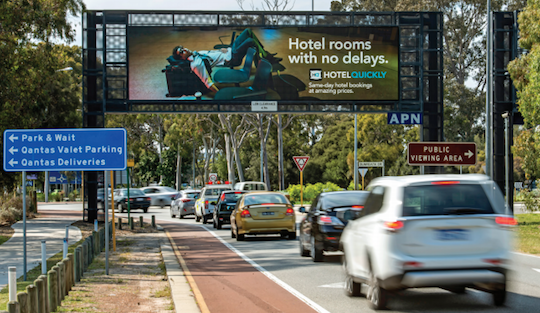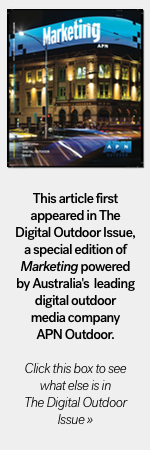Watch, listen and learn
Share

Matt Sandwell reveals how APN Outdoor embraced semiotics and ethnography to help inform its #myrealworld campaign.
The world is an amazing place. It is also a bloody complex one, full of curious and compelling stories of people and how they engage with society, the media,brands and other people.
 This has seen the rise of the capability and desire of marketers to make use of data to solve the problem of complexity. The more people engage, the more information is available to understand the ‘who’, ‘what’, ‘where’ and ‘when’ – job done, right? But what about the story behind the ‘why’?
This has seen the rise of the capability and desire of marketers to make use of data to solve the problem of complexity. The more people engage, the more information is available to understand the ‘who’, ‘what’, ‘where’ and ‘when’ – job done, right? But what about the story behind the ‘why’?
When thinking about the role that qualitative research plays in answering this, the traditional focus group or interview still plays a critical role; however, ethnography and semiotics are increasingly being used to truly get to the heart of meaning in a more complex world.
Finding answers related to people without actually asking them questions may seem counterintuitive; however, semiotics and ethnography are less impacted by issues of hazy recall as the day’s interactions overwhelm people.
In short, people are doing more and remembering less. We need to be in the moment with them, understanding how they actually engage and the reasons behind this, not just what they say they thought, felt and did hours, days, weeks or even months later.
Of course, the power of these methodologies is determined as much by the question the client is wanting answered as anything else, and The Lab was very fortunate with APN Outdoor on the #myrealworld project that their question provided the scope to allow us to truly unpack and understand people’s lives and media interactions.
The brief: ‘help us understand the role that the outside space plays in people’s lives and in particular how this manifests in people’s day-to-day routines’.
It’s a great example of a question that can truly benefit from the answers that semiotics and ethnography can provide.
APN Outdoor’s progressive approach in wanting to understand the category in the broader context of people’s lives and their openness to, what for many is still, a non-traditional approach allows us at The Lab the freedom to let the answer come to us, rather than try to force it into a two-hour focus group.
A little selfishly, it is also the reason why we as researchers head into work with pep in our step on Monday morning!
Without getting too far into the DNA of the approach or the information that we provided to APN Outdoor, the research involved three key things.
1. Starting with clear, consumer hypotheses in mind, driven by the broader culture and context
Briefs such as these can be an exercise in ‘boiling the ocean’ – looking for the answer without some parameters in mind.
In this case, an upfront review of The Lab’s proprietary cultural paradigms study, APN Outdoor’s previous research, semiotic analysis of the outside space in Australian culture, and upfront engagement with APN Outdoor stakeholders was undertaken to ensure that we were focusing on the right areas.
2. Spending time, real time, with the target audience as they go about their day and their activities
On average we spent eight hours with each of the people that were part of the project. This time was over a number of different journeys they undertook, different times of the day, days of the week, modes of transport and so on.
It is amazing what people do that they don’t take notice of or can’t articulate, particularly in what some consider the ‘dead time’ of the daily commute!
3. Not being bound by the purity of research, but focussing instead on understanding people and their story
When we undertake ethnography, we rarely adopt the purist form of ‘bird watching’ where we simply observe and are not seen or heard. Although the purist approach has clear benefits in certain circumstances, a hybrid lets people undertake their behaviour, with occasional clarification or questioning in situ by the researchers to understand the mindsets and motivations behind their actions.
To ensure that the benefits of this approach were understood and the insights embraced by APN Outdoor and its clients:
- We undertook narrative development sessions with APN Outdoor, following the fieldwork, focusing on crafting a clear, compelling and credible story at an individual, segment and overall level rather than endless analysis and content generation.
- Outputs were largely video-based, using the storyline that was developed as the thread that brought together various clips of people’s behaviours or comments, ensuring a more credible, compelling and less contrived output.
- Implications were focused on the future rather than the past or the present, highlighting what all of this means for APN Outdoor’s and its clients’ growth.
We found throughout this process that outdoor advertising enriches, and doesn’t interrupt, people’s lives. The majority of people see it as a welcome distraction and the starting point of a larger conversation. So, what does this all mean for brands and marketers?
In a world where there are more than seven billion individual stories of ever increasing complexity, now more than ever research can and should play a valued role in understanding these stories, the ‘why’ and interpret this narrative in a clear and compelling way.
Finally, semiotics and ethnography are getting their long overdue seat at the table of research in Australia. For APN Outdoor it has provided a powerful tool for unlocking the DNA of the outdoor space, and its role within it. It is just as useful for understanding all aspects of people’s lives as they live them, both offline and online.
Ultimately, the opportunities that ethnography and semiotics provide are as wide and varied as all of the complex, curious and compelling stories of people and their relationship with their worlds – all out there, waiting to be told!















